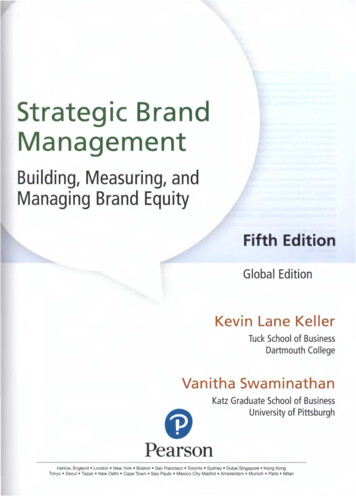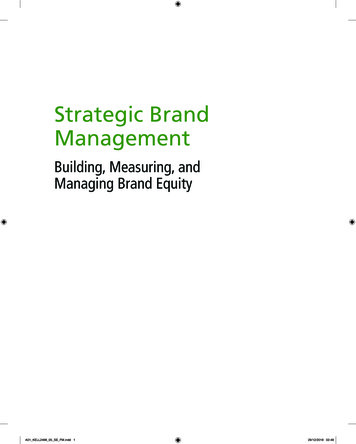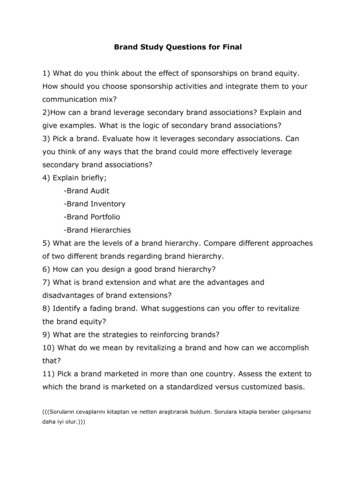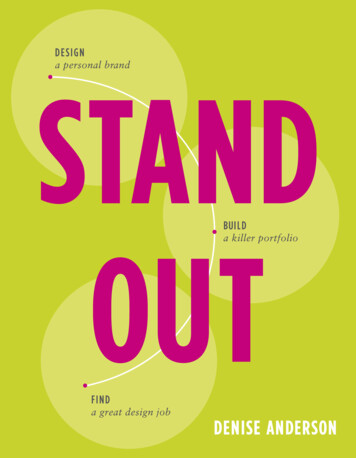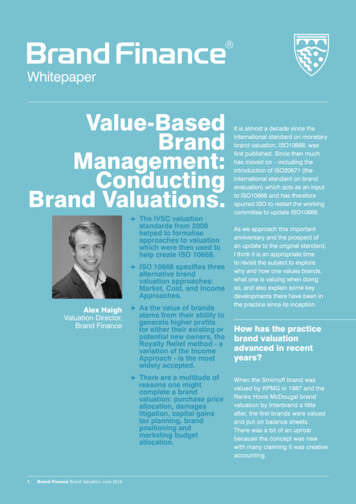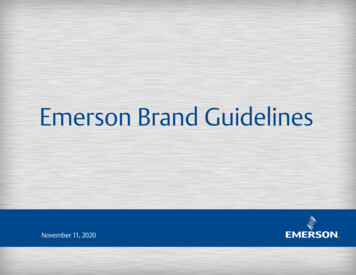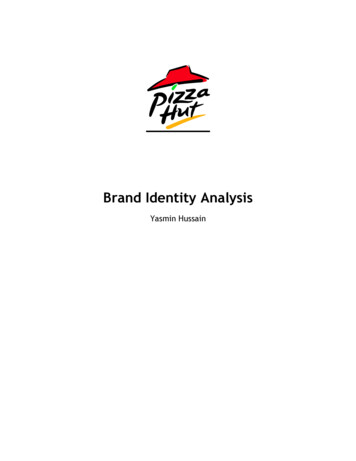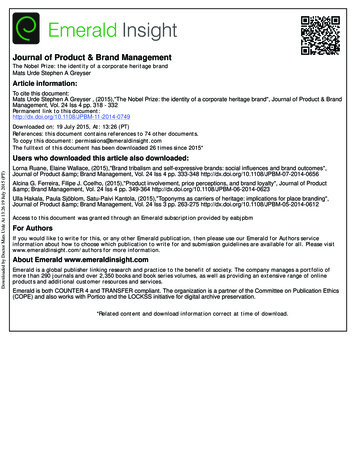
Transcription
Journal of Product & Brand ManagementThe Nobel Prize: the identity of a corporate heritage brandMats Urde Stephen A GreyserArticle information:To cite this document:Mats Urde Stephen A Greyser , (2015),"The Nobel Prize: the identity of a corporate heritage brand", Journal of Product & BrandManagement, Vol. 24 Iss 4 pp. 318 - 332Permanent link to this 49Downloaded on: 19 July 2015, At: 13:26 (PT)References: this document contains references to 74 other documents.To copy this document: permissions@emeraldinsight.comThe fulltext of this document has been downloaded 26 times since 2015*Downloaded by Doctor Mats Urde At 13:26 19 July 2015 (PT)Users who downloaded this article also downloaded:Lorna Ruane, Elaine Wallace, (2015),"Brand tribalism and self-expressive brands: social influences and brand outcomes",Journal of Product & Brand Management, Vol. 24 Iss 4 pp. 333-348 http://dx.doi.org/10.1108/JPBM-07-2014-0656Alcina G. Ferreira, Filipe J. Coelho, (2015),"Product involvement, price perceptions, and brand loyalty", Journal of Product& Brand Management, Vol. 24 Iss 4 pp. 349-364 http://dx.doi.org/10.1108/JPBM-06-2014-0623Ulla Hakala, Paula Sjöblom, Satu-Paivi Kantola, (2015),"Toponyms as carriers of heritage: implications for place branding",Journal of Product & Brand Management, Vol. 24 Iss 3 pp. 263-275 http://dx.doi.org/10.1108/JPBM-05-2014-0612Access to this document was granted through an Emerald subscription provided by eabjpbmFor AuthorsIf you would like to write for this, or any other Emerald publication, then please use our Emerald for Authors serviceinformation about how to choose which publication to write for and submission guidelines are available for all. Please visitwww.emeraldinsight.com/authors for more information.About Emerald www.emeraldinsight.comEmerald is a global publisher linking research and practice to the benefit of society. The company manages a portfolio ofmore than 290 journals and over 2,350 books and book series volumes, as well as providing an extensive range of onlineproducts and additional customer resources and services.Emerald is both COUNTER 4 and TRANSFER compliant. The organization is a partner of the Committee on Publication Ethics(COPE) and also works with Portico and the LOCKSS initiative for digital archive preservation.*Related content and download information correct at time of download.
The Nobel Prize: the identity of a corporateheritage brandMats UrdeDepartment of Business Administration, Lund University School of Economics and Management, Lund, Sweden, andStephen A. GreyserDownloaded by Doctor Mats Urde At 13:26 19 July 2015 (PT)Department of Marketing and Communication, Harvard Business School, Boston, Massachusetts, USAAbstractPurpose – The purpose of this study is to understand the identity of the Nobel Prize as a corporate heritage brand and its management challenges.Design/methodology/approach – An in-depth case study analysed within a heritage brand model and a corporate brand identity framework.Findings – The Nobel Prize is a corporate heritage brand – one whose value proposition is based on heritage – in this case “achievements for thebenefit of mankind” (derived directly from Alfred Nobel’s will). It is also defined as a “networked brand”, one where four independent collaboratingorganisations around the (Nobel) hub create and sustain the Nobel Prize’s identity and reputation, acting as a “federated republic”.Research limitations/implications – The new and combined application of the Heritage Quotient framework and the Corporate Brand IdentityMatrix in the Heritage Brand Identity Process (HBIP) offers a structured approach to integrate the identity of a corporate heritage brand. In anetworked situation, understanding the role of stewardship in collaborating organisations is essential: The network entities maintain their ownidentities and goals, but share common values of the network hub.Practical implications – The integrated frameworks (HBIP) provides a platform for managing a corporate heritage brand.Originality/value – This is the first field-based study of the Nobel Prize from a strategic brand management perspective.Keywords Nobel Prize, Brand stewardship, Corporate brand identity, Corporate heritage brand, Heritage Brand Identity Process,Networked brandPaper type Conceptual paperidentity and use it as a component of their defined brandheritage. For those, heritage helps answer defining questionsrelated to identity such as: “Who are we? Where do we comefrom? What do we stand for? What do we ultimately promiseour stakeholders?”Many brands have a heritage, but only a few can becategorised as heritage brands. Brand heritage is a perspectiveon the past, present and future. It is an overarching conceptthat applies to all brand types and organisations; it is adistillation of an organisation’s heritage. Brand heritage isdefined by Urde et al. (2007, p. 4) as “a dimension of a brand’sidentity found in its track record, longevity, core values, use ofsymbols and particularly in an organisational belief that itshistory is important” (Figure 1). Our definition of a corporateheritage brand is based on Urde et al. (2007, p. 4) original andgeneral definition: “A [corporate] heritage brand is one with apositioning and value proposition based on its heritage”. Forclarity, here, we added “corporate” as a prefix to “heritagebrand”. If our study concerned a product or service brand(which it does not), we could have substituted the prefix“product” or “service”. When evidence shows that a brand“measures up” on all five elements of heritage, it is consideredto have a very high Heritage Quotient (HQ).Related constructs to brand heritage are retro branding (forexample, re-launching of historical brands; Brown et al.,2003), iconic branding (culturally driven branding with highsymbolic content; Holt, 2004), nostalgic branding (linking thepast to the present; Davis, 1979), monarchic branding (forexample, using its monarchy to symbolise nationhood for acountry; Balmer et al., 2006; Balmer, 2011b), and historymarketing (the past as part of business history; Ooi, 2002). TheAn executive summary for managers and executivereaders can be found at the end of this issue.1. IntroductionThe purpose of our study is to understand the identity of theNobel Prize (Nobelpriset) as a corporate heritage brand andits management challenges. This is the first field-based studyof the branding and identity of the Nobel Prize. The broaderaim is to contribute to the theory and practice of the strategicmanagement of corporate brands with a heritage. Thus, wehave introduced the “Heritage Brand Identity Process”. Thisis intended to serve as a structured approach for managingsuch brands.Understanding a corporate brand’s identity and heritage isrelevant and concerns many organisations and institutions.We believe that all established brands have a history, whichmay vary in richness and length. Some brands have recognisedthe relevance of their history and have incorporated it as partof their identity even if only by the phrase “founded in [year]”as a component of its advertisements and website. Amongthese, some have found their history to be a salient part of theirThe current issue and full text archive of this journal is available onEmerald Insight at: www.emeraldinsight.com/1061-0421.htmJournal of Product & Brand Management24/4 (2015) 318 –332 Emerald Group Publishing Limited [ISSN 1061-0421][DOI 10.1108/JPBM-11-2014-0749]318
The identity of a corporate heritage brandJournal of Product & Brand ManagementMats Urde and Stephen A. GreyserVolume 24 · Number 4 · 2015 · 318 –332Figure 1 HQ framework: elements of heritageTrack recordthe intent to [. . .] take the ideas of Alfred Nobel into moderntimes”. To us, this comment illustrates the tension betweenmaintaining links to tradition and also being relevant to thepresent.Here is our roadmap. First, we review the literature withfocus on the management of brand heritage and brandidentity. We describe in more detail a brand heritage modeland a corporate brand identity framework that we will laterapply. Second, we explain our methodology and clinicalresearch related to the case study. Third, we provide anoverview of the Nobel Prize for the reader to understand thehistory, the phenomenon as such and the organisations behindit and related to it. This is essential for the subsequent analysisand the finding that the Nobel Prize can be seen as anetworked brand. Next, we analyse and uncover the heritageof the Nobel Prize. Then, we analyse the identity of the NobelPrize with the help of themes that emerge from the case study.Following that, we define the specific identity of the NobelPrize using a combination of a heritage brand framework andcorporate identity framework described in the literaturereviews. The analysis shows how heritage is an integral part ofthe Nobel Prize identity, thus supporting the finding that it isa corporate heritage brand. Finally, we conclude with keycontributions as we see them, and discuss implications of ourstudy.LongevityBrandStewardshipHistoryimportant toidentityCore valuesUse of symbolsDownloaded by Doctor Mats Urde At 13:26 19 July 2015 (PT)Source: Urde et al. (2007)concept of heritage brands as a distinct category emerged fromanalysis of monarchies as corporate brands, applied tocorporate and organisational branding and revealing them asembracing three time frames – the past, the present and thefuture.All organisations have identity, which may vary in richnessand depth (Melewar and Jenkins, 2002; Knox and Bickerton,2003; Burghausen and Balmer, 2014; Abratt and Kleyn,2011). Many organisations have recognised the importance oftheir identity as an essential source for their branddevelopment and communication. Corporate brand identitydescribes a “distillation of corporate identity” (Balmer, 2010,p. 186).This study is about understanding heritage as part of acorporate brand’s identity. For the management of corporatebrands with a heritage, the challenge is twofold. First, theorganisation has to define, align and develop their brand’sidentity, as is normal in general corporate brand management.Second, the organisation has to consider – if at all or to whatextent – whether their heritage should be part of theircorporate brand’s value proposition and positioning.In the literature, there are corporate brand identity andbrand heritage frameworks, but we have found no integratedframeworks for the management of corporate brands with aheritage. As a response to this theoretical gap, we apply andcombine two existing frameworks in our structured case studyanalysis here.The Nobel Prize is a unique case study to investigate therelationship between identity and heritage, and its managerialchallenges. The identity of the Nobel Prize is based on the willof Alfred Nobel and represents a long history and animpressive heritage. In a real sense, almost everybody knowswhat the Nobel Prize is and what it means, but practicallynobody knows how it comes about. The Nobel Prize is verymuch in the public eye and highly visible as a global entity.Everybody knows it is prestigious but very few know how itacquired its elevated position. Nobody, as far as we know, haswritten about the Nobel Prize from a strategic brandmanagement perspective.In this paper, we are incorporating existing concepts into awider context as a way of looking at brand issues relevant tothe Nobel Prize, including the management of identity andheritage. We also examine stewardship, defined by a memberof a prize-awarding committee this way: “To guard thestanding of the Nobel Prize”. A manager at the NobelFoundation commented on a major challenge for stewardshipin the organisation: “There are initiatives to ‘reach out’ with2. Heritage and identity: a review of theliteratureIn the context of corporate brand management, there are twoconceptual areas of particular relevance to the topic of thisstudy, both theoretically and in practice: corporate brandheritage and corporate brand identity.2.1 Managing corporate brand heritageBrand heritage is an overarching concept and phenomenonthat may be found in all brand types and structures (Aaker,2004 for overview of brand portfolio strategy). Hence, brandheritage may be of relevance for product brands, servicebrands, place brands, country brands and, of course,corporate brands, or combinations thereof (Hakala et al.,2011). For example, Burberry is a corporate heritage brandfounded in 1856, whose portfolio today includes heritageproduct brands such as Burberry Prorsum couture – anexclusive fashion line positioned to appeal to very high-endcustomer segments. The Burberry heritage is used to supportthe authenticity of its entire collection (Alexander, 2009;Beverland, 2005, 2009, Gilmore and Pine, 2007). Heritage,authenticity and luxury are often combined in strategic brandmanagement, with the business model of Louis Vuitton MoëtHennessy as a prime illustration (Kapferer and Bastien, 2009).Heritage related to a brand or an organisation – unlocked ornot – can be a strategic resource when activated and combinedwith other firm resources and may become a competitiveadvantage (see De Wit and Meyer, 2010 for an overview ofresource-based strategy). Unlocking and harnessing thepotentially hidden value of a brand’s heritage calls for specialmanagement competences including stewardship (deChernatony et al., 2009; Burghausen and Balmer, 2014). A keyaspect of brand heritage – given that it is perceived to add value319
Journal of Product & Brand ManagementMats Urde and Stephen A. GreyserVolume 24 · Number 4 · 2015 · 318 –332for customer and non-customer stakeholders (Wiedmann et al.,2011a,2011b) – is its resistance to imitation.Urde et al. (2007) made a distinction between “a heritagebrand” and “a brand with heritage” and emphasised thatmaking heritage part of a brand’s value proposition ultimatelyis a strategic management decision. For example, SC Johnsonand Company, well-known for its household products, callsitself “a family company” (Blombäck and Brunninge, 2009,2013). This refers not only to their consumer products, butsignificantly to the family heritage of the privately owned firm.Separately, the Swiss watch brand Patek Philippe is aheritage brand, as the company has chosen to emphasise itshistory – in the form of tradition – as a key component of itsbrand identity and positioning: “You never actually own aPatek Philippe. You merely look after it for the nextgeneration”. Patek Philippe backs up this brand promise, forexample, through dedicated care and restoration service of itswatches (of any age) for owners (www.patek.com). Incontrast, Urde et al. (2007) categorised TAG Heuer, anotherSwiss timepiece brand, as a brand with a heritage, but not aheritage brand. TAG Heuer’s positioning is in the present –for example, by Formula 1 sponsorship – although it makesreference to its history (“Swiss avant-garde since 1860”).Baum (2011) analysed Swiss watch industry communicationand how differentiation may be achieved among brands byusing heritage. In a different category, the cruise line Cunarddraws significantly on its history of ocean-going elegance.However, according to Hudson (2011), although it is a brandwith heritage, Cunard does not have a demonstrated presenceof all (or most) elements of a heritage brand.management of a (corporate) brand is essentially aboutmanaging its meaning (Park et al., 1986). A vital source forbrand meaning is the corporate identity (acknowledging thatthere are multiple identities; Balmer and Greyser, 2002;Gryd-Jones et al., 2013), and this is distilled into corporatebrand identities that in turn, when communicated andperceived by others, result in a corporate brand (Balmer,2010) with an image and a reputation (Roper and Fill, 2012;de Chernatony and Harris, 2000).A well-defined corporate brand identity is the bedrock oflong-term brand management (Kapferer, 1991, 2012; Urde,1994, 2003; Balmer and Greyser, 2006; Balmer et al., 2013,Balmer, 1995, 2011b; Burmann et al., 2009; de Chernatony,2010). A serious practical management problem is the lack ofa widely agreed framework that can define a corporate brandidentity and also align its different elements so that they cometogether as an entity (Abratt and Kleyn, 2011). Thisdislocation between theory and practice is not only frustratingfor those in charge of corporate brands but, worse, may derailthe brand-building process and ultimately jeopardise theoverall strategy (Aaker, 2004). As a response, the CorporateBrand Identity Matrix (CBIM) was introduced as “a tailoredalternative to existing frameworks, which have often beendesigned for product brands, not corporate brands” (Urde,2013, p. 742).The CBIM structure integrates nine constituent “identityelements” derived from the literature into a 3 by 3 matrix(Figure 2). The arrows radiating from the centre symbolise thestructural nature of all elements. The content of one element“echoes” that of the others, with the core as the “centresquare” of the framework. In a coherent corporate brandidentity, the core reflects all elements, and every elementreflects the core (Urde, 2013).The CBIM’s internal (sender) elements are described in termsof three characteristics of the organisation: its “mission andvision”, its “culture” and its “competences”. The external(receiver) component comprises “value proposition”,2.2 Managing corporate brand identityThe definition and alignment of corporate brand identityconstitute formulation of strategic intent: How theorganisation and its management wants the corporate brand tobe perceived by internal and external stakeholders (Hatch andSchultz, 2008; Kapferer, 2012; Balmer, 2011b). TheWhat are our key offerings andhow do we want them toappeal to customers and noncustomer stakeholders?Relationships:What should be the natureof our relationships withkey customers and noncustomer stakeholders?External / InternalExternalFigure 2 The corporate brand identity matrixExpression:What is unique or specialabout the way wecommunicate and expressourselves making itpossible to recognise us ata distance?Brand Core:What do we promise,and what are the corevalues that sum upwhat our brand standsfor?InternalDownloaded by Doctor Mats Urde At 13:26 19 July 2015 (PT)The identity of a corporate heritage brandMission & Vision:What engages us, beyondthe aim of making money(mission)? What is ourdirection and inspiration(vision)?Culture:What are our attitudesand how do we work andbehave?Source: Urde (2013)320Position:What is our intended positionin the market, and in the heartsand minds of key customersand non-customerstakeholders?Personality:What combination ofhuman characteristics orqualities forms ourcorporate character?Competences:What are we particularlygood at, and whatmakes us better than thecompetition?
Downloaded by Doctor Mats Urde At 13:26 19 July 2015 (PT)The identity of a corporate heritage brandJournal of Product & Brand ManagementMats Urde and Stephen A. GreyserVolume 24 · Number 4 · 2015 · 318 –332“relationships” and “position”. The matrix is completed by threeelements that are both internal and external. “Personality”describes the corporate brand’s individual character, whereas“expression” defines the verbal and visual manifestations of thebrand. The “brand core”, consisting of a brand promise andsupporting core values, is at the heart of the corporate brandidentity (Urde, 2013).As part of our analysis of the Nobel Prize, we use the CBIMfor its capacity to, “explore corporate brand identity internallyand externally and by focusing on the brand core” (Urde,2013, p. 742). As a management tool, the framework isdesigned to support all those working operationally orstrategically with the corporate brand identity. Each of thenine key framework elements is described by a “guidingquestion”, the purpose of which is to initiate the discussion ofa particular element in practice (Urde, 2013). These guidingquestions will help us to define the key identity elements of theNobel Prize. The HQ model’s five elements will also guide ouranalysis of the heritage of the Nobel Prize. Our exploration ofboth identity and heritage is, as far as we know, a newcombined application of the CBIM and the HQ model.over 20 interviews with 17 individuals (see Appendix). Wehave individually interviewed (1.5-2.5 hours) the fourselection committee heads (in Stockholm and Oslo), the presentand former directors of the Nobel Foundation, three Nobellaureates, the director of Nobel Media and the director of theNobel Museum. The Nobel Foundation and the Nobel Museumhave supplied us with relevant documents, for example,regarding the history of the Nobel Prize. Accreditation to the2013 and 2014 Nobel award ceremony and the banquet inStockholm afforded first-hand observation, which encompassedseeing the active roles of cooperating Nobel networkorganisations, noting the attendance of prior laureates (“the paststrengthening the present”, in terms of heritage) and keysponsors, recognising the use of Nobel-related symbols, andexperiencing the atmosphere of the ceremonies.4. Understanding the Nobel Prize and its historyThe historical background of the Nobel Prize is important forunderstanding its identity, especially because of the consistencyof its structure and procedures and its value over time. Morebroadly, the history of awards relate to cultural value and prestige(English, 2005). The legacy of Alfred Nobel – the Nobel Prize –constitutes a landmark in this context (Sohlman, 1983; Feldman,2012). Oxford Dictionary defines the Nobel Prize as “the world’smost prestigious award”.Its extraordinary reputation is confirmed by StanfordPresident John Hennessy:3. Case study methodologyOur overall approach draws on two models from the literature:The HQ model and the CBIM. Our research is thus deductivewhen applying and analysing our case using existing theory,and inductive in our attempts to integrate and develop newconcepts and theories based on our clinical field research – theNobel Prize case. Further, we combine the two frameworks inan analytic sequence that we term “Heritage Brand IdentityProcess”. The structure of the analysis in our paper followsthis process. We envision our conceptual contributions fromthis research primarily to be related to “delineating andintegrating new perceptions” (MacInnis, 2011, p. 138) of theidentity of a corporate heritage brand and its managementchallenges.To develop and apply ideas beyond the currentunderstanding, it is essential in the Nobel Prize case to gainaccess to the organisation itself (Gummesson, 2005),especially how its different component (network) entities thinkabout the organisation and its work. To us, it is essential thatthe research results “fit” within the reality of the caseorganisation (and its embedded network organisations).Further, we think the research results should “work” – in thesense that the research results are understandable andpotentially useful for those we have met in our field researchand practitioners within the field (Glaser and Strauss, 1967;Jaworski, 2011). A key aspect of clinical research is to movefrom the practical to the general (Barnes et al., 1987;Eisenhardt, 1989; Flyvbjerg, 2006).The case study used a multi-method approach to datagathering and analysis (Gummesson, 2005). The unit ofanalysis is the Nobel Prize network of multiple independentcollaborating institutions; this implies a study of relatedinstitutions, organisations and stakeholders (Figure 2). Weused open and semi-structured interviews, including the nine“guiding identity questions” from the CBIM (see Figure 2)and “heritage elements” from the HQ model (see Figure 1),document and archival studies and observation in the researchprocess (Bryman and Bell, 2011). In total, we have conductedIn the [Silicon] Valley, everyone talks about your IPO [Initial PublicOffering to the stock market] [. . .] but in the sciences they talk about goingto Stockholm [as Nobel laureates], and you go to Stockholm only if youmake a fundamental breakthrough that really reshaped the field. That’s thekind of impact we really look for in our research (Financial Times, 3 February2014).Moreover, research universities with laureates often point tothis as a mark of distinction, as do science-based researchentities such as the prestigious Marine Biological Laboratory,USA. The Nobel Prize was possibly the first intellectual prizeof its kind and was introduced at a time when the modernOlympics was established (1896). Michael Sohlman, formerDirector of the Nobel Foundation, described it to us as: “theOlympics of the intellect”.4.1 The Alfred Nobel legacy and the willIn 1888, Alfred Nobel was astonished to read his ownobituary, titled The merchant of death is dead, in a Frenchnewspaper. Because it was Alfred’s brother who had died, theobituary was eight years premature (Larsson, 2010). Nobel(1833-1896) was the inventor of Dynamite (a registeredtrademark) and held patents for many inventions; the first(1863) was for his “method of preparing gunpowder for bothblasting and shooting”. Alfred Nobel was born in Sweden andalso lived in France, Russia and Italy. He was awarded anhonorary doctorate by Uppsala University in Sweden (Fant,1991). Nobel was a cosmopolite, spoke five languages and hadnot been a registered resident of any country since the age ofnine; therefore, he was jokingly called “The richest vagabondin Europe” (Sohlman, 1983, p. 86).When Nobel died in 1896, he left one of the largest fortunesof his century. “His handwritten will contained no more thanan outline of his great visionary scheme for five prizes”(Sohlman, 1983, p. 1). A section of the will reads:321
The identity of a corporate heritage brandJournal of Product & Brand ManagementMats Urde and Stephen A. GreyserVolume 24 · Number 4 · 2015 · 318 –332interrelated institutions, organisations and individuals(Hobsbawn and Ranger, 1983; Fant, 1991; Feldman, 2012).What is reported in international media during the annualNobel Week is in fact only the tip of an iceberg. Through astrategic brand management lens, we see the Nobel Prize as anetworked corporate heritage brand, characterised by a Nobelofficial as: “A small federative republic” (Figure 3).The Nobel Prize is the “hub” of the network and the core ofits brand identity (centre; first circle). Four prize-awardinginstitutions (second circle), the Nobel Foundation (thirdcircle), as well as the Nobel Museum, Nobel Peace Center andNobel Media (fourth circle) make up the principal entities inthe “federation”. The laureates represent an essential part ofthe network and are also stakeholders (outer circle). They allcommunicate the “Nobel Prize” directly or indirectly. Thescientific communities, general public and media are examplesof key stakeholder groups important for the network’sreputation. We have found in the course of our research thatthe concept of a “networked brand” is useful to understandingthe modus operandi of the Nobel Prize. For an overview of thenetwork theory, see Ford et al. (2011), Leek and Mason(2009), Ramos and Ford (2011).To prepare the groundwork for our analysis, we brieflydescribe the Nobel Prize, starting with its hub.[. . .] constitute a fund, the interest on which shall be annually distributed inthe form of prizes to those who, during the preceding year, shall haveconferred the greatest benefit to mankind (www.Nobelprize.org).Downloaded by Doctor Mats Urde At 13:26 19 July 2015 (PT)Those who are still entrusted to carry out the final wishes ofAlfred Nobel describe the Will to us as “a strength and a ruler”and as “a constitution”. The Nobel Prize has been awardedsince 1901 for “the benefit of mankind” to be continuedeternally. This responsibility characterises the Nobel Prize andthe people behind it.4.2 The prestige of the Nobel PrizeThe Nobel Prize is considered to mark the beginning of amodern age of awards (English, 2005). The custom of culturalawards can be traced back at least to the sixth century B.C., inGreece (Hobsbawn and Ranger, 1983). In the earlyRenaissance, the practice became common with the rise ofroyal and national academies, e.g. the French Academyfounded in 1672. The Nobel Prize was a “catalyst for a processthat had been gaining momentum for some time” (English,2005, p. 53).Based on the literature and our interviews, we see four mainreasons that explain why the Nobel Prize has acquired itsprestige and elevated position.First, the Nobel Prize was one of the first internationalprizes to be established in a time when nationalism was strong.From a draft of the Nobel will:4.3.1 The Nobel PrizeThe Nobel Prize is a group of awards living together. The Willis a primary source of its identity, and the combination ofawards and what they contribute to the network all help createits unique character. The former director of the Foundationexplains the roles, relations and different audiences of theawards:[. . .] in awarding the prizes no consideration whatever shall be given to thenationality of the candidates, but that the most worthy shall receive theprize, whether [. . .] Scandinavian or not (Nobelprize.org).The Nobel Prize has always cast a global shadow. The formerDirector of the Nobel Foundation said to us: “There is anideology based on the values of the Enlightenment and itscosmopolitan nature”.Second, the Nobel Prize gained immediate attention andmedia coverage, and stirred curiosity, debate and critique(Källstrand, 2012) [One issue cited was] “[. . .] the difficultieswhich might face the prize-giving bodies in accomplishingtheir task, [for example] that the work would interfere withtheir members’ main functions” (Sohlman, 1983, p. 84).Third, is recognition of the absolute criteria and rigour inthe processes to award the Nobel Prize. A member of aprize-awarding (scientific) committee commented succinctlyto us: “The discovery. That’s it. We disregard other aspects”.The same person un
Brand heritage is an overarching concept and phenomenon that may be found in all brand types and structures (Aaker, 2004 for overview of brand portfolio strategy). Hence, brand heritage may be of relevance for product brands, service brands, place brands, country brands and, of course, co

